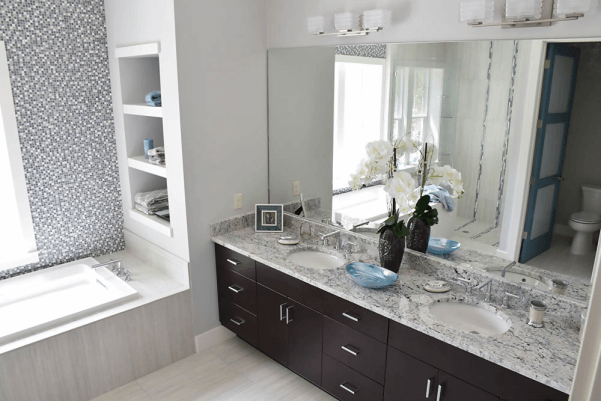There are numerous materials that are used to make vanity countertops. While some of the materials have many similarities, all of them have something unique that contributes to its strengths as well as weakness. The main materials that are used to make bathroom vanities include ceramic, concrete, natural stone, etc. Choosing the right material means that you get to maximize the usage of the space and overall décor.
Factors To Consider When Choosing A Countertop Material
In this article, we’ll look at the main factors to consider when choosing countertop materials and compare some of the common materials that are used. We’ll start with the factors to consider:
- Cost
You need to have a budget of approximately how much you’re willing to spend on the vanities. Research manufacturers and read reviews online before you commit to making a purchase. At least that way you will be sure to get value for your money.
- Daily Care and Maintenance
When it comes to keeping the countertops looking as good as new, prevention is better than cure. Make sure that the cleaning detergents you use do not stain or bleach. Always keep the surfaces as clean as possible and wipe spills promptly.
Depending on the type of surface, you might need to polish it regularly so that it remains smooth and reflective.
- Durability
Go for a material that will last longer without needing to be replaced every now and then. To further improve the durability, use specific cleaners, laminate, or seal the surface if necessary.
- Aesthetics
The more unique the vanity is the more beautiful it’ll look. You can have the vanity made into your design and color of choice making it a work of art.
Comparing Different Counter Tops
Once upon a time, the options for bathroom vanities and countertops were so limited. Today, there are very many options for countertops in the market that choosing between them can be a challenge.
We’ll look at the different materials and their pros and cons to help you make a better decision.
- Ceramic
This is the material that was mainly used for traditional countertops. It’s still widely used thanks to the many trendy and modern innovations. Ceramic is a good choice for when one is looking to save some money on a quality countertop. Their hardness makes them for countertops and floors too
Pros
- Ceramic can mimic other materials such as wood or leather and gives many design options.
- Easy to install making it a feasible DIY project
- Relatively affordable
Cons
- Brittle and cracks under pressure or on impact
- The grout lines stain and discolor easily
- Concrete
This one-of-a-kind material is not only limited to sidewalks; it’s also suitable for countertops and gives different feels ranging from rustic to modern. This makes them very a versatile option for several kitchen designs ranging from organic, natural feel, or down-to-earth
Since the concrete surfaces are handmade from scratch, they can incorporate any color, pattern, and texture.
Pros
- Fairly eco-friendly so they’re appealing to homeowners who are focused on environmental issues
- Maintaining concrete surfaces is quite easy
- Strong and durable
- Concrete can be tinted and textured
Cons
- Once scratched, the scratches can develop to cracks after which repair is not an option. The only option is a replacement.
- There’s no DIY option. These countertops have to be installed by professionals
- Quite expensive
- Natural stone
Different types of stones are used to make bathroom vanities. These include slate, soapstone, limestone, marble, travertine, onyx, and granite. Each stone has its own set of pros and cons but we’ll look at the general pros and cons.
Pros
- Premium building material that sends a message of luxury
- Unique. It’s hard to find countertops that look alike
Cons
- Considerably more expensive as compared to other materials
- Most types of stone need to be sealed and more delicate care and maintenance.


